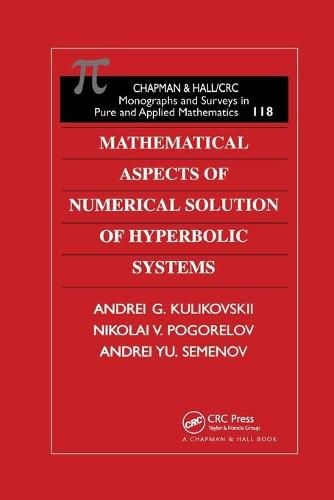Readings Newsletter
Become a Readings Member to make your shopping experience even easier.
Sign in or sign up for free!
You’re not far away from qualifying for FREE standard shipping within Australia
You’ve qualified for FREE standard shipping within Australia
The cart is loading…






This important new book sets forth a comprehensive description of various mathematical aspects of problems originating in numerical solution of hyperbolic systems of partial differential equations. The authors present the material in the context of the important mechanical applications of such systems, including the Euler equations of gas dynamics, magnetohydrodynamics (MHD), shallow water, and solid dynamics equations. This treatment provides-for the first time in book form-a collection of recipes for applying higher-order non-oscillatory shock-capturing schemes to MHD modelling of physical phenomena.
The authors also address a number of original nonclassical problems, such as shock wave propagation in rods and composite materials, ionization fronts in plasma, and electromagnetic shock waves in magnets. They show that if a small-scale, higher-order mathematical model results in oscillations of the discontinuity structure, the variety of admissible discontinuities can exhibit disperse behavior, including some with additional boundary conditions that do not follow from the hyperbolic conservation laws. Nonclassical problems are accompanied by a multiple nonuniqueness of solutions. The authors formulate several selection rules, which in some cases easily allow a correct, physically realizable choice.
This work systematizes methods for overcoming the difficulties inherent in the solution of hyperbolic systems. Its unique focus on applications, both traditional and new, makes Mathematical Aspects of Numerical Solution of Hyperbolic Systems particularly valuable not only to those interested the development of numerical methods, but to physicists and engineers who strive to solve increasingly complicated nonlinear equations.
$9.00 standard shipping within Australia
FREE standard shipping within Australia for orders over $100.00
Express & International shipping calculated at checkout
Stock availability can be subject to change without notice. We recommend calling the shop or contacting our online team to check availability of low stock items. Please see our Shopping Online page for more details.
This important new book sets forth a comprehensive description of various mathematical aspects of problems originating in numerical solution of hyperbolic systems of partial differential equations. The authors present the material in the context of the important mechanical applications of such systems, including the Euler equations of gas dynamics, magnetohydrodynamics (MHD), shallow water, and solid dynamics equations. This treatment provides-for the first time in book form-a collection of recipes for applying higher-order non-oscillatory shock-capturing schemes to MHD modelling of physical phenomena.
The authors also address a number of original nonclassical problems, such as shock wave propagation in rods and composite materials, ionization fronts in plasma, and electromagnetic shock waves in magnets. They show that if a small-scale, higher-order mathematical model results in oscillations of the discontinuity structure, the variety of admissible discontinuities can exhibit disperse behavior, including some with additional boundary conditions that do not follow from the hyperbolic conservation laws. Nonclassical problems are accompanied by a multiple nonuniqueness of solutions. The authors formulate several selection rules, which in some cases easily allow a correct, physically realizable choice.
This work systematizes methods for overcoming the difficulties inherent in the solution of hyperbolic systems. Its unique focus on applications, both traditional and new, makes Mathematical Aspects of Numerical Solution of Hyperbolic Systems particularly valuable not only to those interested the development of numerical methods, but to physicists and engineers who strive to solve increasingly complicated nonlinear equations.